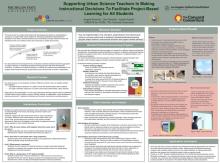Objective: The Next Generation Science Standards affirm an important vision for science education: Science for all students (AAAS, 1994; NRC, 2012b). In this vision, teachers engage students in three-dimensional (3D) learning by braiding scientific content with scientific and engineering practices and crosscutting concepts while fostering inclusive science classrooms. This approach aims to provide opportunities for all students to develop and use knowledge to make sense of phenomena experienced in their world and find solutions to problems (NRC, 2012b). Supporting teachers in transforming their teaching to 3D instruction while meeting all students’ learning needs will require sustained support, and time to adapt (Reiser, 2013; Wilson, Schweingruber, & Nielsen, 2015). Teachers need access to rich curricular materials that support three-dimensional instruction, and knowledge of practices that support all students in science. In this study, we explore how use of an educative, project-based, 3D science curriculum paired with professional learning of inclusive 3D instruction impacts instructional decisions. Five high school teachers from the Los Angeles Unified School District implemented a 3D, project-based curriculum, Interactions, that focused on supporting student’s learning about the forces that hold matter together. Concurrently teachers participated in a blended, year-long professional learning program (PLP).
Theoretical Framework: Our PLP draws on the five features of effective professional development: 1) focus on content knowledge, 2) engaging teachers in active learning, 3) coherent program, 4) sustained duration, and 5) collective participation (Desimone & Garet, 2015; Luft & Hewson, 2014). Instructional coaching served as an important component of our PLP to support teachers in examining their practice, and for connecting them to professional networks to increase social capitol (Taylor, 2008). One way we connected teachers to professional networks was by engaging them in a virtual, weekly professional learning community – a group of teachers with common learning goals who meet regularly to collaborate and shape their instruction (Richmond & Manokore, 2011).
Methods: Our year-long PLP consisted of five activities: 1) a 3-day summer institute to introduce the curriculum, 2) analyzing student work within a virtual, weekly professional learning community, 3) reviewing research-based strategies within a virtual, weekly professional learning community, 4) Saturday sessions to share instructional strategies and explore 3D assessment, and 5) individual instructional coaching to promote change. Of the five teachers who participated in curriculum implementation and our PLP, two teachers were selected for case-study analysis.
Data Sources: Data collection included video-recorded classroom observations, video-recorded professional learning sessions, audio-recorded interviews, and examples of student work. We developed case studies chronologically for each teacher combing summaries for all data sources.
Results: Our findings indicate that providing teachers with sustained, research-based curricular and instructional supports assists them in making instructional decisions that bridges 3D learning with the unique needs of their students.
Significance: Our findings support research that curricular materials, and professional learning activities, often influence the instructional decisions that teachers make (Jones & Tarr, 2007) and indicate that quality curricular materials and professional support are important in fostering instructional changes such as the shift to 3D instruction and developing inclusive, three-dimensional science classrooms.
